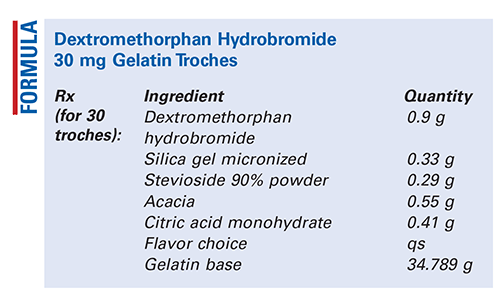US Pharm. 2022;47(7):59-60.

Method of Preparation: Calculate the required quantity of each ingredient for the total amount to be prepared. Accurately weigh or measure each ingredient. Melt the gelatin base using a hot water bath, stirring frequently, and keep the melted base heating on the hot water bath. Triturate the powders in a mortar until finely pulverized. Sift the powders into the melted base and stir until evenly dispersed. Add the flavor and mix well. Reheat mixture in the water bath, if necessary, to obtain a pourable melt. Pour into a 30-count troche mold and allow to congeal at room temperature. Package and label.
Use: These troches have been used to decrease cough and alleviate pain.
Packaging: Package in tight, light-resistant
containers.
Labeling: Keep out of reach of children. Discard after ____ [time period].
Stability: Check the appropriate state board of pharmacy requirements or the current edition of the U.S. Pharmacopeia for the appropriate beyond-use date.1
Quality Control: Quality-control assessment can include weight, specific gravity, active drug assay, color, clarity, texture–surface, appearance, feel, melting test, dissolution test, physical observation, and physical stability.2,3
Discussion: Dextromethorphan hydrobromide (C18H25NO.HBr.H2O, MW 370.32) occurs as practically white crystals or as a crystalline powder with a faint odor. It melts at about 126°C with decomposition. Dextromethorphan hydrobromide is sparingly soluble in water, and it is freely soluble in alcohol.1
Silica gel, a form of silicon dioxide, is obtained by insolubilizing the dissolved silica in sodium silicate solution. If obtained by adding sodium silicate to a mineral acid, it is called silica gel; if obtained by destabilization of a solution of sodium silicate to yield very fine particles, it is called precipitated silica. Silica gel occurs as a fine, white, hygroscopic, odorless, amorphous powder with a usual particle size of 2 µm to 10 µm. It is insoluble in water and alcohol.4
Stevia is a natural, nontoxic, and safe sweetening agent extracted from the leaves of the Stevia rebaudiana Bertoni plant. It occurs as a white, crystalline, hygroscopic powder that is approximately 300 times as sweet as sucrose. Stevia is commonly used in foods, and it may be used in both hot and cold preparations.5
Acacia (gum acacia, gum arabic) is the dried gummy exudate obtained from the stems and branches of some species of acacia. It is a complex aggregate of sugars and hemicelluloses with a molecular weight in the range of 240,000 to 580,000. Acacia is used as an emulsifying agent (5%-10% concentration), pastille base (10%-30% concentration), suspending agent (5%-10% concentration), and tablet binder (1%-5% concentration), as well as in cosmetics, confectionery, and food products.6
Citric acid monohydrate (C6H8O7.H2O) occurs as colorless or translucent crystals or as a white, crystalline, efflorescent powder that is odorless and has a strong, tart, acidic taste. One gram is soluble in less than 1 mL of water and 1.5 mL of ethanol.7
Gelatin troche base may be prepared as follows: Heat a water bath to boiling. In a separate beaker, add glycerin (100 mL) and purified water (14 mL); heat for 5 minutes while stirring. Slowly, over 3 minutes, add the gelatin (28 g) to the glycerin-water mixture while stirring, and continue heating for no more than 45 minutes. Remove from heat, cool, and store in a refrigerator until use.8
REFERENCES
1. U.S. Pharmacopeia/National Formulary [current revision]. Rockville, MD: U.S. Pharmacopeial Convention, Inc; June 2022.
2. Allen LV Jr. Summary of quality-control testing for sterile and nonsterile compounded preparations, part 1: physical and chemical testing. IJPC. 2019;23(3):211-216.
3. Allen LV Jr. Summary of quality-control testing for sterile and nonsterile compounded preparations, part 2: microbiological testing. IJPC. 2019;23(4):299-303.
4. Antic A, Hapgood KP. Silicon dioxide, anhydrous. In: Sheskey PJ, Hancock BC, Moss GP, Goldfarb DJ, eds. Handbook of Pharmaceutical Excipients. 9th ed. London, England: Pharmaceutical Press; 2020:911-915.
5. Brayfield A, ed. Martindale: The Complete Drug Reference. 38th ed. London, England: Pharmaceutical Press; 2014:2214.
6. Kibbe AH, Quinn ME. Acacia. In: Sheskey PJ, Hancock BC, Moss GP, Goldfarb DJ, eds. Handbook of Pharmaceutical Excipients. 9th ed. London, England: Pharmaceutical Press; 2020:61-63.
7. Watters M. Citric acid. In: Sheskey PJ, Hancock BC, Moss GP, Goldfarb DJ, eds. Handbook of Pharmaceutical Excipients. 9th ed. London, England: Pharmaceutical Press; 2020:295-298.
8. Allen LV Jr. Atropine 1 mg gelatin troches. IJPC. 2003;7(1):56.
The content contained in this article is for informational purposes only. The content is not intended to be a substitute for professional advice. Reliance on any information provided in this article is solely at your own risk.
To comment on this article, contact rdavidson@uspharmacist.com.





